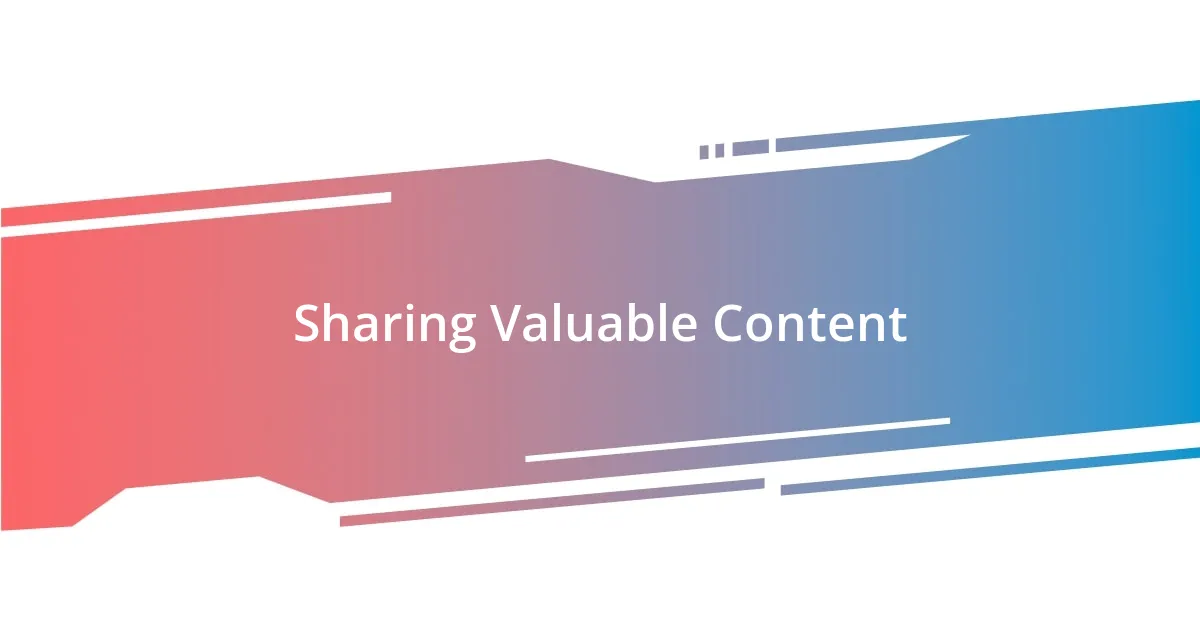Key takeaways:
- Focus on joining a few high-quality Facebook groups that align with your interests to maximize engagement and connections.
- Engage actively with members through thoughtful contributions, listening, and sharing valuable resources to build relationships and trust.
- Analyze group demographics and engagement patterns to identify your target audience and tailor your interactions effectively.
- Measure success by setting tangible goals and seeking feedback to refine content and enhance community impact.

Understanding Facebook Groups
Facebook groups are unique communities that offer a space for like-minded individuals to gather and share ideas. I remember joining a group focused on small business growth, and it felt like finding a second home. There’s something powerful about connecting with people who share your passion and understanding your challenges.
Have you ever found yourself overwhelmed by the sheer number of Facebook groups? I certainly did. It’s easy to get lost in the sea of options, but not all groups are created equal. Some serve as valuable hubs of information and support, while others may feel like a cluttered marketplace. I’ve learned that focusing on a few high-quality groups that align with my interests yields the best results.
Engaging with Facebook groups can be both exciting and daunting. Sometimes, I hesitate to share my thoughts or questions, wondering if others will find them valuable. But what I’ve discovered is that vulnerability often leads to deeper connections. When I finally opened up about my experiences, not only did I receive meaningful advice, but I also fostered relationships that enriched my journey. Isn’t it fascinating how a simple click can have such significant emotional impacts?

Identifying Your Target Audience
Identifying your target audience within Facebook groups can be a game-changer for your engagement strategy. I remember the early days when I joined many groups, trying to figure out where I fit in. It was overwhelming! But then, I realized the importance of digging deep to understand who I was trying to connect with. Knowing their interests and needs allowed me to tailor my interactions and make meaningful contributions rather than just making noise.
Here are some useful tactics for pinpointing your target audience:
- Analyze Group Demographics: Look at the group members’ profiles to gauge their age, location, and professional backgrounds.
- Observe Engagement Patterns: Pay attention to the types of posts that generate the most reactions. What topics get people talking?
- Participate in Discussions: Join conversations to better understand the pain points and interests of group members.
- Ask Questions: Don’t hesitate to reach out with polls or direct inquiries—this not only provides insights but also fosters connection.
- Monitor Group Rules: Each group has its own culture. Recognizing and respecting these can help you align with the right audience.
With these strategies, I found myself more connected and engaged, building relationships that were both valuable and rewarding. When I targeted my efforts, it was like turning on a spotlight in a dim room; suddenly, everything became clearer and more vibrant.

Choosing the Right Groups
Choosing the right Facebook groups is crucial for maximizing your experience. I’ve often found myself contemplating which groups to join, driven by my desire for genuine engagement. One memorable moment was when I stumbled upon a niche group dedicated to eco-friendly living, which perfectly matched my passion for sustainability. The sense of belonging I found there made the choice worthwhile, proving to me that aligning with your interests can create enriching discussions and support.
As I navigated the sea of groups, I learned to prioritize quality over quantity. Joining too many can be tempting, but I realized that simply lurking without participating left me feeling disconnected. In my journey, focusing on a few well-curated groups has led to invaluable connections. I was initially hesitant to post about my commitment to reducing plastic waste, worried about judgment. However, sharing my struggles sparked an inspiring dialogue, showcasing the power of targeted group selection.
Evaluating a group before joining can help avoid the wrong fit. It’s essential to consider the group’s number of active members, the tone of discussions, and the level of support offered. I recall leaving a group that was overly promotional and lacking engagement, which left me feeling unmotivated. Finding groups that inspire and uplift you can elevate your experience significantly.
| Criteria | Group A | Group B |
|---|---|---|
| Active Members | 1500 | 300 |
| Engagement Level | High | Low |
| Focus Area | Eco-friendly Living | General Marketplace |

Engaging with Group Members
Engaging with group members is where the real magic happens. I vividly recall a time when I decided to host a live Q&A session within my favorite group. The excitement from members was palpable, and I was amazed at how quickly people jumped in with questions. This interaction not only deepened my connection with the group but also opened the door to friendships I never expected.
To truly connect, active listening is key. I remember a moment when a member shared a heartfelt story about their struggles in a recent project. Instead of just liking the post, I took the time to comment thoughtfully, offering support and sharing my own experiences. It felt rewarding to see how a simple act of kindness sparked a lengthy discussion, proving just how impactful genuine engagement can be.
Every interaction is an opportunity to build rapport. One approach I’ve found effective is to share relevant resources—whether articles, videos, or tools I love. It’s like adding little gifts to a conversation. I once shared a helpful guide on sustainable living in my eco-group, and the overwhelming gratitude from members showed me that providing value not only boosts engagement but also fosters a sense of community. How do you feel when someone shares something that resonates with you? It’s that warmth and connection I strive to create in every interaction.

Sharing Valuable Content
Sharing valuable content in Facebook groups can truly transform the dynamics of a community. I remember once posting a comprehensive list of eco-friendly brands I discovered, accompanied by my personal experiences with each. The response was incredible—members expressed gratitude and shared their own favorites, turning my post into a lively discussion. It was a reminder that my knowledge and experiences could contribute to others, creating a sense of camaraderie and shared purpose.
Moreover, I’ve had success with curating content that directly addresses the needs of the group. For instance, after noticing many members struggling with meal prep, I crafted a simple recipe guide, complete with tips and time-saving suggestions. The excitement from group members was palpable, and several even shared their own variations. It’s remarkable to see how tailored content not only provides value but also elevates the overall conversation within the group.
Reflecting on my journey, I believe that authenticity is crucial when sharing content. I often ask myself, “What do I wish I had known when I began?” This question has guided me in creating posts that resonate deeply with others. By being transparent about my challenges and offering advice from my experiences, I’ve been able to foster connections that feel meaningful. After all, what’s more valuable than sharing insights that can genuinely help someone else?

Building Authority and Trust
Building authority and trust within Facebook groups is essential for establishing a reliable presence. I recall a time when I initiated a series of themed discussions, focusing on specific topics of interest each week. Those occasions not only showcased my expertise but also encouraged group members to openly share their thoughts. Witnessing thoughtful conversations unfold felt incredibly rewarding—it was a testament to the trust I had built with the community.
One crucial aspect of nurturing this trust is being consistent and available. I made it a point to check in daily, responding to questions and comments with patience and encouragement. I remember one member who was struggling with a project and needed guidance. Instead of offering a quick solution, I walked them through my thought process, sharing my own past mistakes and how I learned from them. It transformed our interaction from a simple exchange to a collaborative problem-solving experience, reinforcing trust on both sides.
Ultimately, transparency plays a significant role in building authority. I regularly share my journey, including successes as well as failures. I vividly recall posting about a project that didn’t go as planned and how I pivoted from it. This honesty resonated deeply with members. It’s emotional to put yourself out there, but it creates a bond that’s difficult to break. How can we expect others to trust us if we only present our success stories? Sharing both sides not only makes us relatable but strengthens our credibility within the community.

Measuring Your Success
Measuring success in Facebook groups can often feel a bit abstract, but I find that setting tangible goals is key. For instance, after a month of posting consistently, I would look at the engagement metrics—likes, comments, and shares. One month, I noticed that my posts about productivity hacks received ten times more interaction compared to others. This insight made me realize the power of focusing on topics that genuinely resonate with the community. Isn’t it rewarding to see your contributions make a measurable impact?
I also incorporate feedback loops to evaluate my success. After sharing a particularly helpful resource, I asked group members what they thought through a quick poll. The enthusiastic responses not only affirmed that I was on the right track but also sparked an idea for my next post. It’s amazing how a simple question can lead to deeper connections and help refine our content. Have you ever thought about how direct feedback can shape your approach in these communities?
Reflecting on the nature of success, I remind myself that it’s not just about numbers. I remember celebrating when a member reached out to me, expressing how my tips had significantly improved their workflow. These personal stories become my guiding star. They remind me that the true measure of success lies in the positive impact I have on others. After all, isn’t the ultimate goal to make a meaningful difference in someone else’s life?















